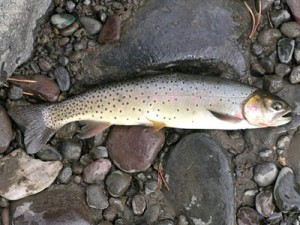
The annual removal of nonnative lake trout from Yellowstone Lake recently concluded, with results suggesting a declining population of the problematic fish.
Lake trout are removed in an effort to preserve the native cutthroat trout population, the largest remaining concentration of inland cutthroat trout in existence.
This Native cutthroat trout is Yellowstone’s most ecologically important fish. It is an important food source for grizzly bears, birds of prey, and other wildlife. Cutthroats are highly regarded by anglers.
The cutthroat decline resulted in several of these species being displaced from Yellowstone Lake or having to use alternate food sources during certain times of the year.
Yellowstone National Park and contract crews removed 282,960 fish between May and October of this year compared to 297,110 in 2018, and 396,950 in 2017, a 29% decline over three years.
Yellowstone’s lake trout suppression program is one of the largest nonnative fish removal programs in the United States. Since lake trout were first discovered in 1994, more than 3.4 million have been removed from Yellowstone Lake through suppression gillnetting.
The number of lake trout caught in nets continues to steadily decline, from 4.4 per net in 2017, and 3.1 per net in 2018, to just 2.9 per net in 2019.
In order to predict the success of the removal effort and set benchmarks for gillnetting in the future, Yellowstone National Park and Michigan State University collaborate to generate statistical models of the lake trout population.
The models suggest there are 73% less lake trout ages six and older in Yellowstone Lake now than were present at the population’s peak in 2011. This is critical because older, larger lake trout have the highest reproductive potential and consume the most cutthroat trout. The models also indicate that the invasive species has been in decline since 2012.
Concurrent with the lake trout decline, long-term monitoring indicates a substantial increase in the number of cutthroat trout in the Yellowstone Lake ecosystem. Cutthroat that inhabit the lake migrate more than 30 miles up into the Upper Yellowstone and Thorofare streams where they spawn and then return to the lake.
This July, fisheries staff found large numbers and sizes of cutthroat in these backcountry streams. Ten years ago, few cutthroat were present. This long distance migration highlights the spatial extent to which the recovery of the cutthroat impacts Yellowstone.
While models and monitoring point to positive trends, a panel of expert fishery scientists in May 2019, estimate that a minimum of five more years of effort is needed to reach the lake trout population goal of below 100,000.
They also emphasized that lake trout cannot be completely eradicated with current techniques and will continue to require annual removal and monitoring into the future.
Yellowstone fishery biologists continue to explore alternatives to gillnetting that will augment lake trout suppression, increase efficacy, and reduce costs. Over the last few years, biologists tested a method to suppress the population by killing lake trout eggs on spawning sites. The results have been promising, and NPS intends to expand the technique in the future.
Yellowstone has invested more than $20 million over the past two decades on this recovery effort. Much of that funding has come from the generosity of donations through Yellowstone Forever.
More information can be found at the 2015 – 2018 YCR Fish Report (https://www.nps.gov/yell/learn/fishreports.htm) and Native Fish Conservation Program (https://www.nps.gov/yell/learn/management/native-fish-conservation-program.htm).
source: National Park Service